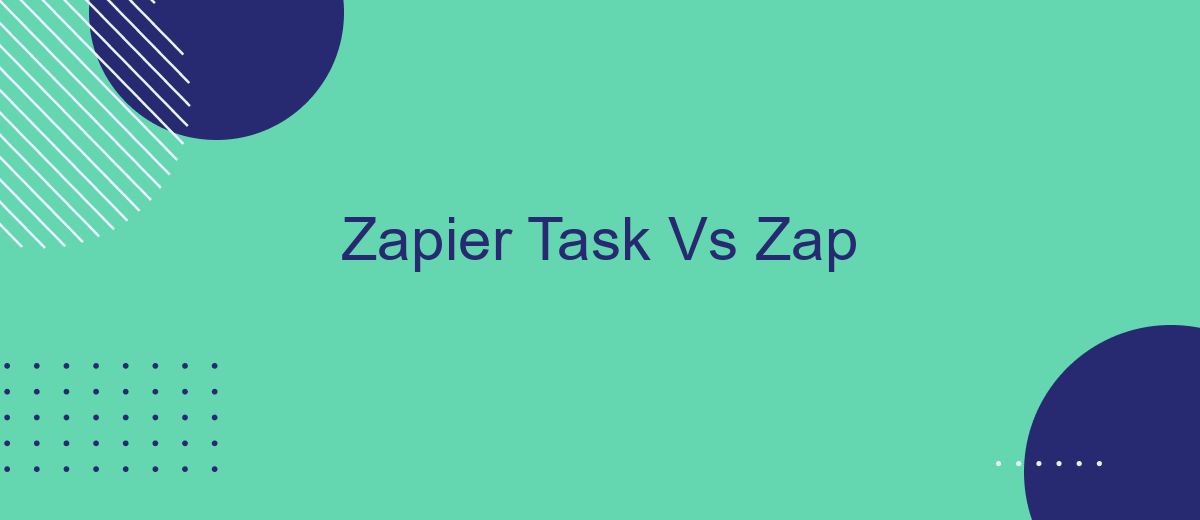In the realm of automation, understanding the distinction between a Zapier Task and a Zap is crucial for optimizing workflows. A Zap is an automated workflow that connects your apps and services, while a Task is a single action within that workflow. This article delves into their differences, helping you harness the full potential of Zapier for seamless automation.
Overview
Zapier is a powerful automation tool that connects various apps and services to streamline workflows. The platform operates on two primary components: Tasks and Zaps. Understanding the difference between these two is crucial for maximizing efficiency and effectiveness in your automation processes.
- Tasks: Individual actions performed by Zapier within a Zap, such as sending an email or updating a record.
- Zaps: Automated workflows that consist of a series of tasks triggered by specific events.
For those seeking more advanced and customizable integration solutions, services like SaveMyLeads offer additional functionality. SaveMyLeads simplifies the process of connecting various platforms, ensuring that data flows seamlessly between them. Whether you're a small business or a large enterprise, leveraging these tools can significantly enhance productivity and operational efficiency.
Features

Zapier offers two primary features: Tasks and Zaps. Tasks are individual actions executed within a workflow. For example, sending an email, creating a new record, or updating a database entry. Each Task represents a single step in a process, and the number of Tasks you can execute depends on your Zapier plan. Zaps, on the other hand, are automated workflows that connect your apps and services. A Zap consists of a trigger and one or more actions (Tasks), allowing you to automate repetitive tasks and streamline your workflows.
SaveMyLeads is another excellent service that simplifies the process of setting up integrations. It offers a user-friendly interface and pre-built templates to connect various apps and services effortlessly. Unlike Zapier, which may require more manual configuration, SaveMyLeads provides a more straightforward approach, making it easier for users with limited technical skills to automate their workflows. Both Zapier and SaveMyLeads aim to enhance productivity by reducing manual efforts and ensuring seamless data flow between different platforms.
Pricing

When considering the pricing of Zapier's Task and Zap, it's important to understand how each is billed. Zapier's pricing model is based on the number of Tasks you use and the complexity of your Zaps.
- Free Plan: Limited to 100 Tasks per month and basic Zaps.
- Starter Plan: Costs .99/month and includes 750 Tasks per month with multi-step Zaps.
- Professional Plan: Priced at /month, offering 2,000 Tasks per month and advanced features like custom logic.
- Team Plan: Costs 9/month, providing 50,000 Tasks per month with team collaboration tools.
- Company Plan: Custom pricing for over 100,000 Tasks per month and enterprise-level features.
For those seeking an alternative for setting up integrations, SaveMyLeads offers a competitive pricing structure with a focus on ease of use and quick setup. This service can be a cost-effective solution for businesses looking to automate their workflows without the complexities and higher costs associated with more advanced plans.
Pros and Cons

When comparing Zapier Tasks and Zaps, it's crucial to understand their distinct functionalities and how they impact your workflow. Zapier Tasks represent individual actions performed within a Zap, while Zaps are the automated workflows themselves. Each has its own set of advantages and disadvantages that can influence your decision-making process.
One of the main benefits of using Zaps is their ability to automate complex workflows, saving you significant time and effort. On the other hand, Tasks allow for granular control over each step within a workflow, which can be advantageous for fine-tuning specific actions. However, there are also some drawbacks to consider.
- Pros of Zaps: Simplifies automation, integrates multiple apps, saves time.
- Cons of Zaps: Can be complex to set up, may require a premium plan for advanced features.
- Pros of Tasks: Detailed control, customizable actions, better for specific needs.
- Cons of Tasks: Can become overwhelming with too many steps, might need technical knowledge.
Services like SaveMyLeads can further simplify the process by providing pre-built integrations and a user-friendly interface, making it easier to set up and manage your Zaps and Tasks. Ultimately, the choice between Zaps and Tasks will depend on your specific requirements and the complexity of your workflows.
Conclusion
In conclusion, understanding the differences between a Zapier Task and a Zap is crucial for optimizing your workflow automation. A Task represents a single action executed within a Zap, which is a complete workflow consisting of multiple steps. By effectively managing these components, you can streamline your processes, save time, and improve productivity.
For those looking to further simplify and enhance their integration setups, services like SaveMyLeads can be invaluable. SaveMyLeads offers a user-friendly platform that automates lead management and integrates seamlessly with various applications, reducing the complexity of manual configurations. Utilizing such tools can significantly enhance your automation strategy, ensuring that your business operations run smoothly and efficiently.


FAQ
What is the difference between a Task and a Zap in Zapier?
How does the number of Tasks affect my Zapier usage?
Can I run multiple Zaps simultaneously?
How can I monitor my Task usage in Zapier?
Are there alternatives to Zapier for automation and integrations?
SaveMyLeads is a simple and effective service that will help you automate routine tasks and optimize business processes. Stop wasting time uploading leads from Facebook manually – you can do it automatically, saving a lot of time and money. Eliminate routine from workflows and achieve more with minimal investment of money, effort and human resources.
